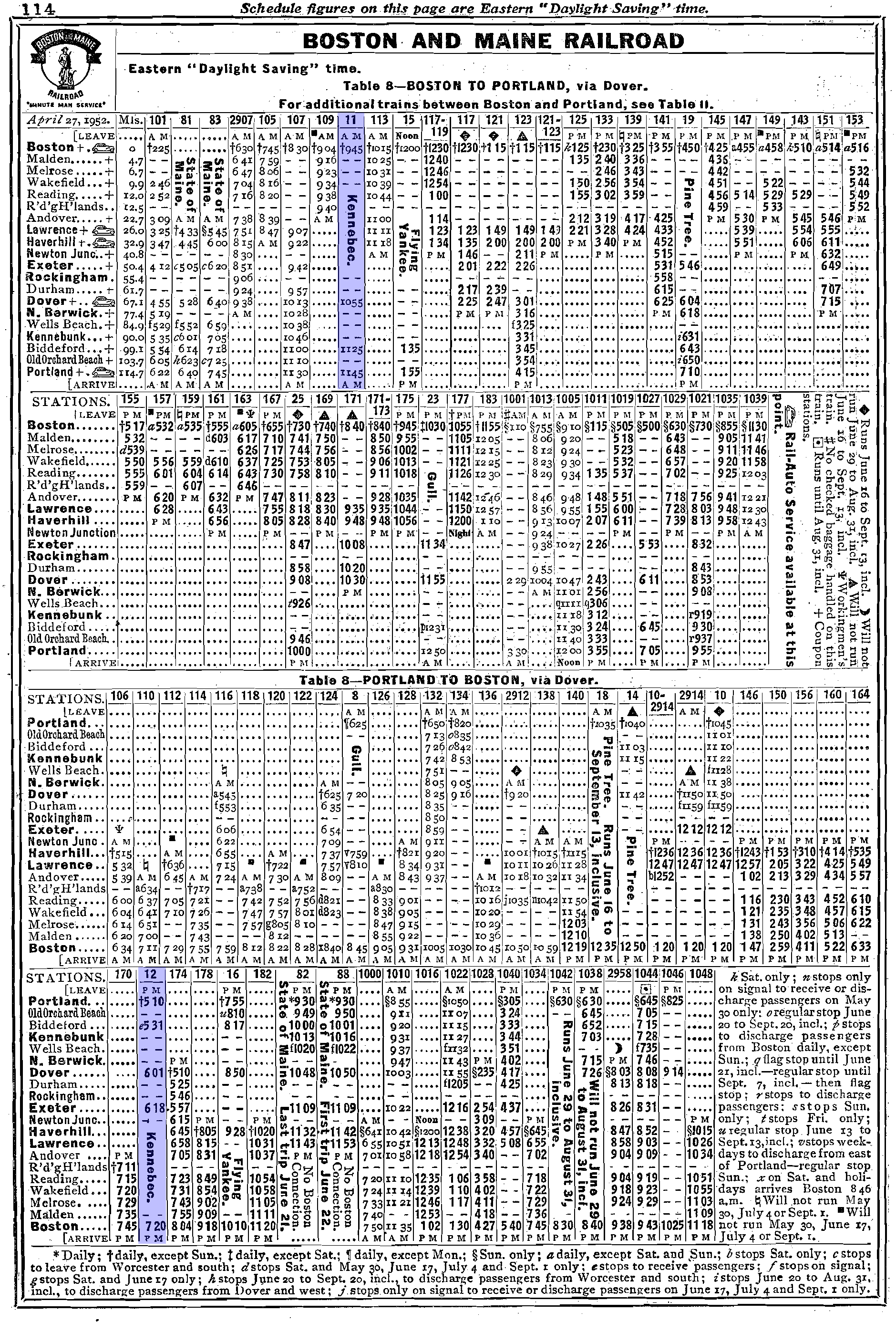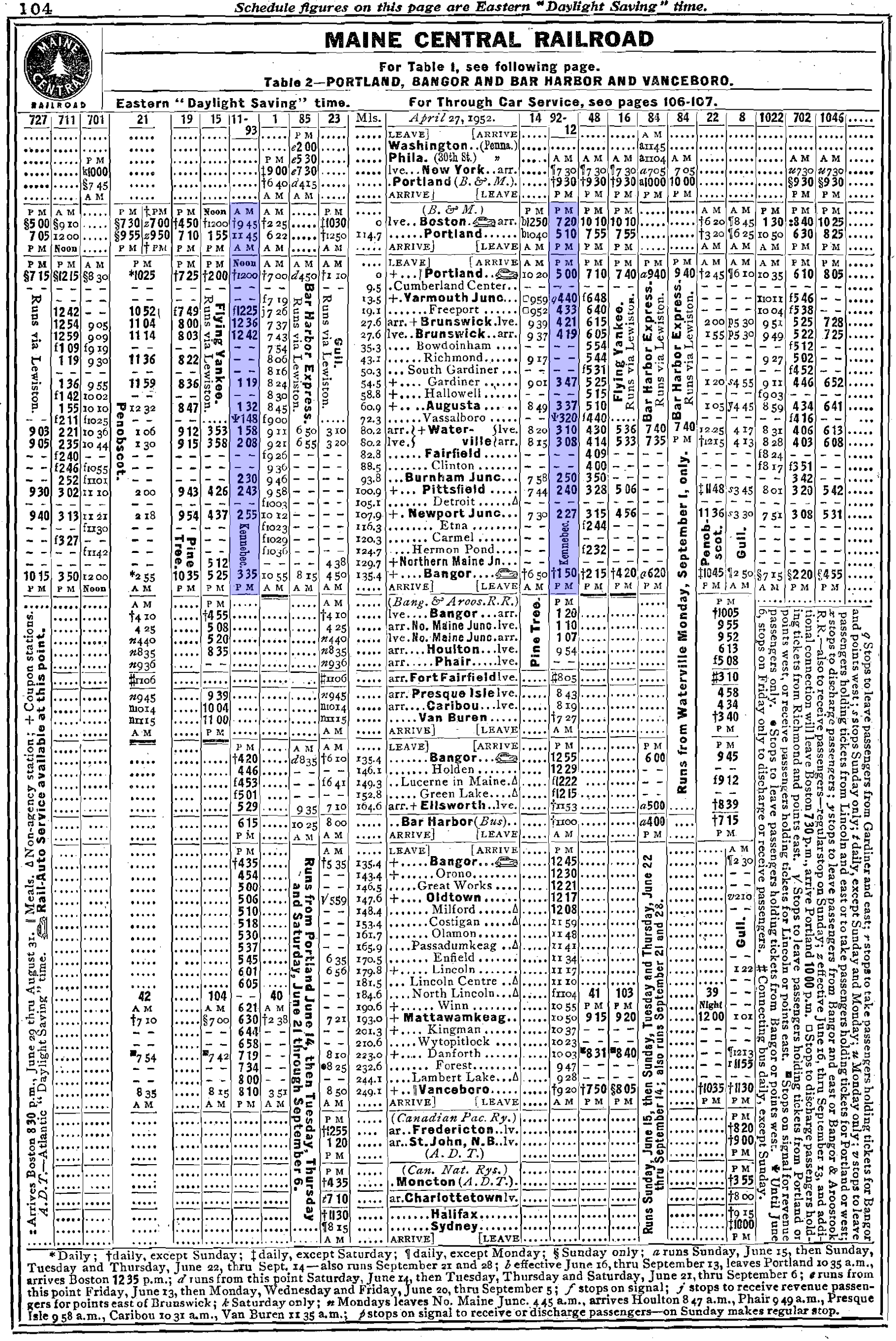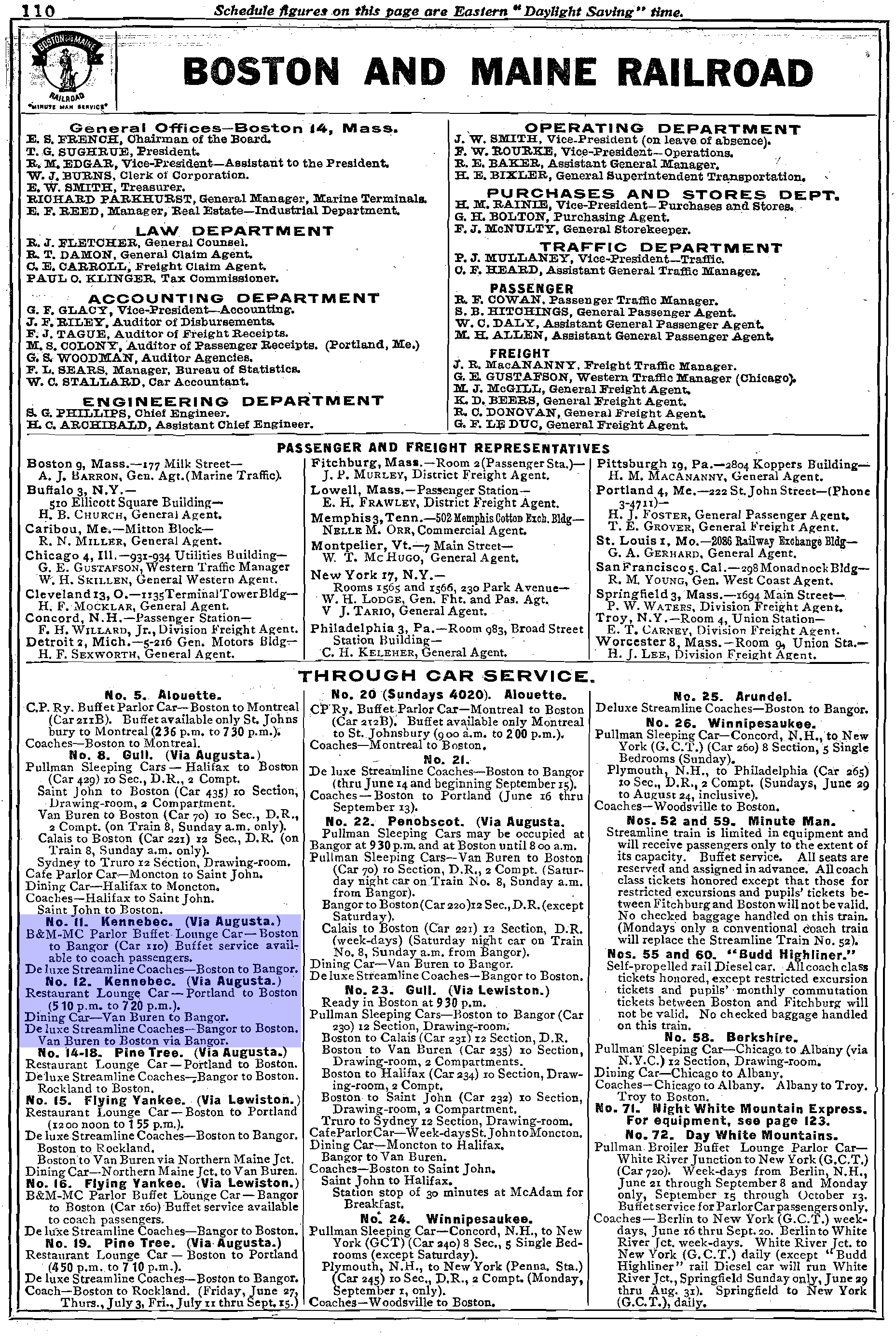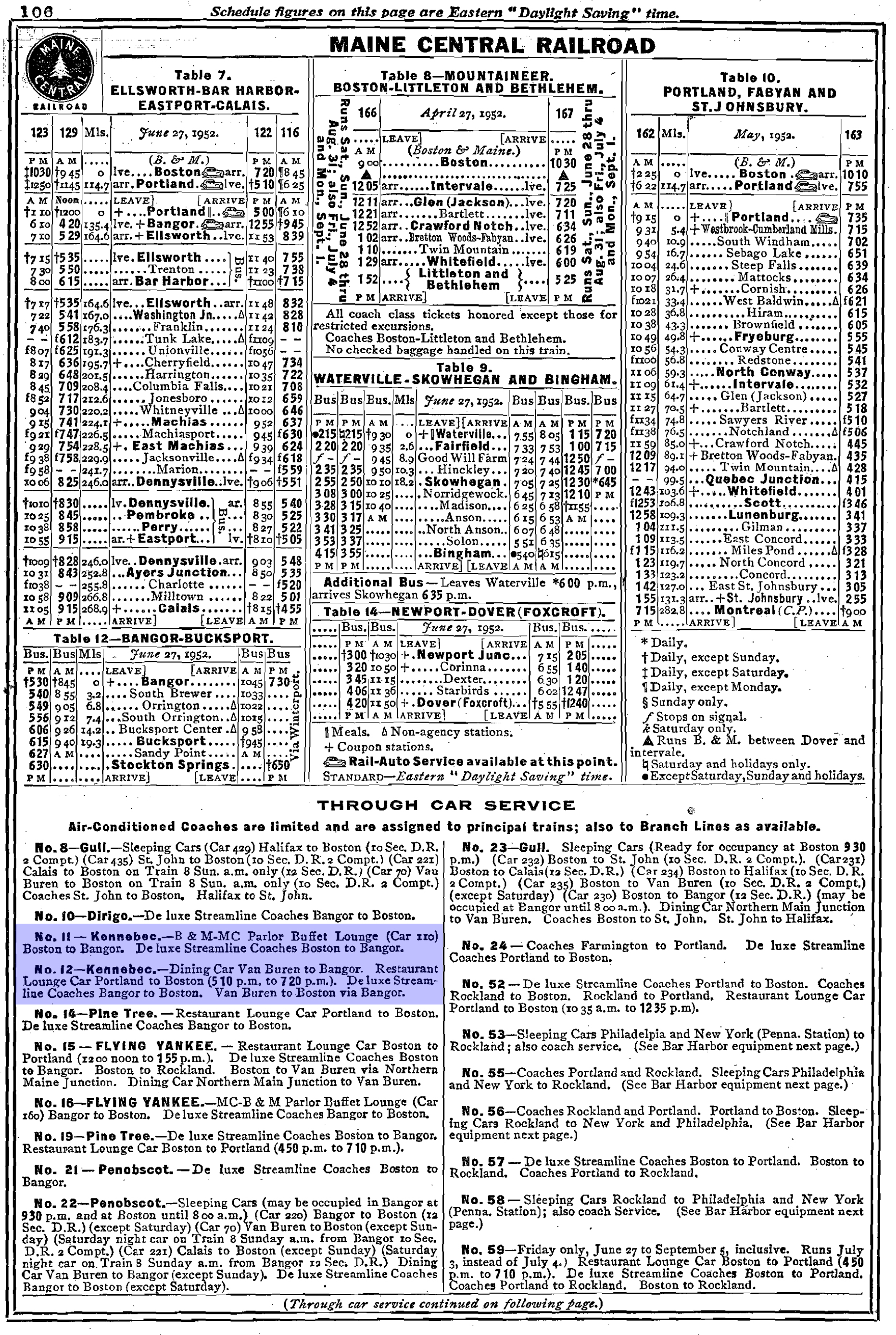"Kennebec" (Train): Consist, Route, Timetable
Last revised: September 15, 2024
By: Adam Burns
For many years the Boston & Maine and Maine Central, two of northern New England's largest railroads, provided a wide range of passenger services throughout the region.
Many of these were concentrated around the busy Boston-Bangor, Maine corridor with the most important being the Pine Tree Limited, Kennebec, and Flying Yankee.
The latter was one of New England's first streamliners, launched in 1935. It closely resembled Burlington's famous stainless-steel trainset, which had been unveiled the previous year.
The service these trains provided greatly improved when the B&M and MEC came under common management during the early 1930s - which lasted for more than two decades. Sadly, all three met a quick demise not long after receiving lightweight equipment and were only ghosts of their former selves by the mid-1950s.
By the post-World War II era passenger rail service was fading and short-to-intermediate services like the Kennebec were early victims. By the end of the decade all three trains had vanished.
Photos
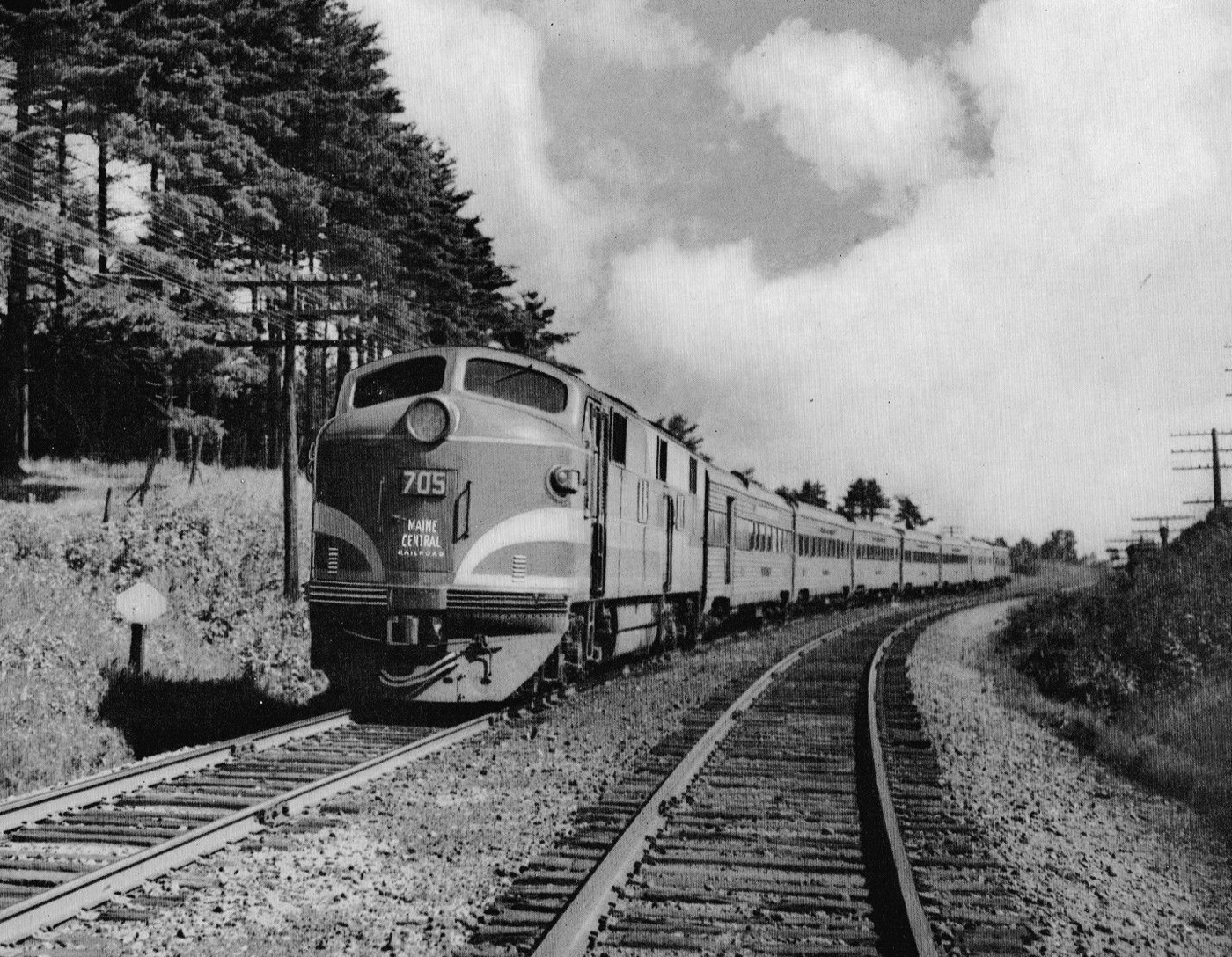 A Maine Central publicity photo of the "Kennebec" led by E7A #705. The caption notes the train carries, "...new de luxe, post-war coaches and restaurant-lounge cars."
A Maine Central publicity photo of the "Kennebec" led by E7A #705. The caption notes the train carries, "...new de luxe, post-war coaches and restaurant-lounge cars."Northeastern Rail Service
When one thinks of Northeastern rail service thoughts of the Pennsylvania, New Haven, and New York Central often come to mind.
However, the former reached no further north than New York and the latter served only Massachusetts. As a result, smaller systems were left to provide service to northern New England such as Vermont, New Hampshire, and Maine.
The two largest, and most important, included the Boston & Maine and Maine Central. For many years they were close partners in providing the public with high quality service along their respective routes.
The above-noted Flying Yankee, or #6000, was a three-car articulated trainset manufactured by the Edward G. Budd Manufacturing Company of Philadelphia in 1935. Just like its Burlington counterpart the streamliner was an instant hit, offering a fast schedule and comfortable acommodations between Boston-Bangor.
For several years it remained popular but as demand outstripped available capacity the set was reassigned to other corridors after 1940 carrying names such names as the Businessman, Minute Man, Mountaineer and Cheshire.
Prior to the addition of gleaming, lightweight cars the principal limited trains serving the Boston-Bangor included the Flying Yankee, Kennebec, and Pine Tree Limited. For years they operated with standard heavyweight equipment (baggage-coach combine, coaches, diner, a parlor, and observation) and traditional steam power.
Timetable (June 27, 1952)
According to Kevin Holland's book Passenger Trains Of Northern New England, In The Streamline Era all three retained their heavyweight status through the late World War II era, save for the #6000 trainset and Boston & Maine's "American Flyer" streamlined coaches it had acquired in 1935.
New Equipment
During November of 1945, B&M and MEC placed a whopping $2 million order to Pullman-Standard for 24 new, lightweight cars - clad in stainless steel sheathing, which mimicked the look of Budd's designs - to partially reequip the three trains.
The cars included the following accommodations and were split between the two roads:
- 16 standard coaches (56 seats including a 10-seat smoking section)
- 4 restaurant-lounge cars (24 dining seats with 18 lounge seats)
- 4 baggage coaches (36 coach seats with a 29-foot, 6-inch baggage room)
Timetable (April 25, 1948)
| Time/Leave (Train #11) | Milepost | Location | Time/Arrive (Train #12) |
|---|---|---|---|
| 8:45 AM (Dp) | 0.0 | 6:20 PM (Ar) | |
| 10:45 AM (Ar), 11:00 AM (Dp) | 114.7 | 4:20 PM (Dp), 4:05 PM (Ar) | |
| 11:36 AM | 142.3 | 3:24 PM | |
| 12:14 PM | 169.2 | 2:47 PM | |
| 12:24 PM | 175.6 | 2:37 PM | |
| 12:53 PM (Ar), 12:58 PM (Dp) | 194.9 | 2:10 PM (Dp), 2:05 PM (Ar) | |
| 1:19 PM | 208.5 | 1:47 PM | |
| 1:28 PM | 215.6 | 1:36 PM | |
| 1:40 PM | 222.6 | 1:24 PM | |
| 244.4 | 12:55 PM | ||
| 2:25 PM | 250.1 | 12:40 PM |
Pullman delivered most of the order during May of 1947 with the restaurant-lounges arriving that August. Considering the trains' regional nature and the railroads' size it was an impressive display of services.
The interiors were clad in beautiful shades of blue, yellow, green, red, brown, and cream. There was full dining services available, separate sections for smokers, and even a bar-lounge.
The equipment was led by new streamlined E7s, products of Electro-Motive, that were dressed in a handsome livery of deep maroon with gold trim. In all, B&M acquired 21 examples between 1945 and 1949 (3800-3820) and the Maine Central 7 between 1946 and 1948 (705-711).
According to one B&M advertisement:
"In these new coaches on the B&M's diesel-powered Kennebec, Pine Tree, and Flying Yankee it takes just two hours flat to make the 115 mile Boston-Portland run. One of the B&M's new coaches has been on exhibition at the Chicago Railroad Fair."
Inauguration
The Kennebec was listed as trains #11 (officially railroad eastbound) and #12 (officially railroad westbound), operating weekly except Sunday. The train had received its name in 1936, originally known as the Kennebec Limited, a renaming of what was formerly formerly theYankee.
Typical of B&M practice from that period, the railroad held a public contest asking school children for name entries. It was a popular tradition among all involved - both railroad and the general public - in the naming of everything from locomotives to passenger cars. The Kennebec received its calling card from a 12-year-old by the name of Edward Murch.
Consist (June 27, 1952)
Final Years
Unfortunately, the B&M and MEC experienced sagging interest in passenger trains following World War II, a not uncommon issue affecting the entire industry during that time.
The anticipated surge in traffic wrought by returning veterans never materialized and railroads watched helplessly as patrons left the rails in droves for highways and airlines.
This was especially true in New England were population centers were only a short distance apart, making the automobile the fast and more affordable option, especially as road and highways improved.
As early as the mid-1950s both railroads were losing interest passenger operations. The B&M - under the failed management of Patrick McGinnis (1956) - only expedited the process, and both railraods spent most of the latter half of the decade canceling as many trains as possible.
On September 6, 1960 the Maine Central ended all passenger service across its system citing declining ridership, which was partly driven by lack of support from one-time partner B&M.
Sources
- Holland, Kevin J. Passenger Trains Of Northern New England, In The Streamline Era. Lynchburg: TLC Publishing, 2004.
- Schafer, Mike. Classic American Railroads. Osceola: MBI Publishing, 1996.
- Schafer, Mike. Classic American Railroads, Volume III. Osceola: MBI Publishing, 2003.
Contents
Recent Articles
-
Nevada - Murder Mystery - Dinner Train Rides
Dec 14, 25 12:40 PM
Seamlessly blending the romance of train travel with the allure of a theatrical whodunit, these excursions promise suspense, delight, and an unforgettable journey through Nevada’s heart. -
West Virginia - Murder Mystery - Dinner Train Rides
Dec 14, 25 12:32 PM
For those looking to combine the allure of a train ride with an engaging whodunit, the murder mystery dinner trains offer a uniquely thrilling experience. -
Kansas - Murder Mystery - Dinner Train Rides
Dec 14, 25 11:02 AM
Kansas, known for its sprawling wheat fields and rich history, hides a unique gem that promises both intrigue and culinary delight—murder mystery dinner trains.

